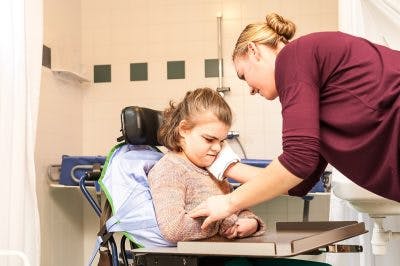Did you know that roughly 75% of people with cerebral palsy experience pain?
Cerebral palsy-related pain is complex and can be caused by the motor disorder itself or by its many secondary complications. Abnormal muscle tone can shorten the muscles, misalign the joints, and deform the bones, causing pain.
Unfortunately, pain is often overlooked and insufficiently treated, which can negatively affect one’s appetite, sleep, and behavior.
This article will go over the different types of pain an individual with cerebral palsy might experience and how to manage them to maximize quality of life.
Common Types of Pain Experienced by Cerebral Palsy Patients

Every case of cerebral palsy is unique and everyone will experience pain differently.
The three main types of pain associated with cerebral palsy are musculoskeletal, gastrointestinal, and procedural pain. Below, we’ll discuss the distinctions between them.
1. Musculoskeletal Pain
The most common type of pain experienced by individuals with cerebral palsy is musculoskeletal pain.
Musculoskeletal pain can be caused by:
- Hip dislocation
- Dystonia (uncontrollable muscle activity)
- Spasticity (abnormally high muscle tone)
- Scoliosis (sideways curving of the spine)
- General stress on the muscles, bones, and joints for prolonged periods
This type of pain often described as achy and is usually felt in the limbs, back, and neck.
2. Gastrointestinal Pain
Gastrointestinal pain results from problems in the digestive tract. Digestive complications are common amongst individuals with cerebral palsy because impaired mobility can affect activity levels, metabolism, and control over the bowel and bladder muscles.
Common digestion-related problems in individuals with cerebral palsy include:
- gastroesophageal reflux disorder
- urinary incontinence
- constipation
- dysphagia (difficulties swallowing)
Gastrointestinal pain is typically felt at or near the abdominal muscles in the form of cramps, aches, or heartburn.
3. Procedural Pain
Procedural or surgical pain is the result of invasive procedures.
The body needs time to adjust after surgery, and pain following a procedure is a very common side effect.
Luckily, procedural pain is temporary and should go away with time.
Signs of Pain in Children with Cerebral Palsy

Children with severe motor impairments may have difficulties communicating that they are in pain.
Therefore, it’s essential for parents to keep an eye out for other ways their child might be expressing pain, including:
- Crying
- Strained facial expressions
- Reduced activity
- Moaning
- Irritability
- Lack of cooperation
- Poor sleep
- Stiffness
- Fidgety movements
Now that you understand the different ways a child with CP may indicate they’re in pain, let’s go over how to minimize pain.
Pain Management for Cerebral Palsy Patients

Depending on the cause of pain, individuals with cerebral palsy can employ a variety of treatment interventions.
In fact, patients typically use a combination of multiple treatments to manage their pain. What works for one person may not work for the other, so an individualized approach to pain relief is necessary.
Exercise and Physical Therapy
Physical therapy can be helpful for cerebral palsy patients experiencing musculoskeletal pain.
Exercising helps expand range of motion, strengthen muscles, and improve flexibility.
Physical therapists can also provide tips and tricks to help make postures and movements easier and more natural so that you feel less pain.
Exercise improves circulation and regulates neurotransmitter levels in the brain, which can also alter your perception of pain.
Medications
Depending on the cause and severity of your pain, doctors will recommend various types of medications.
Some of the most common medications prescribed for pain in cerebral palsy patients are:
- Anticonvulsants: Even if your child isn’t experiencing epilepsy, anticonvulsants can help reduce pain. They calm the nerves to reduce pain sensations.
- Antidepressants: Antidepressants can alter neurotransmitter levels in the brain to reduce the perception of pain.
- Opioids: Opioids are powerful medications that inhibit pain signals. However, they are addictive and one can build a tolerance to them relatively quickly, so they are only ideal for short term use.
- Non-steroidal Anti-Inflammatory Drugs (NSAIDs): You can easily get NSAIDs like ibuprofen and aspirin at your local drug store without a prescription. They help reduce inflammation to alleviate muscle and joint pain.
- Anticholinergics: Anticholinergics block acetylcholine from causing involuntary muscle movements in the gastrointestinal tract and other areas in the body.
- Baclofen: Baclofen is a muscle relaxant that can be injected, pumped, or taken orally to reduce spasticity.
- Botox: Small doses of Botox can be injected into the body for spasticity treatment. It temporarily blocks chemical signals that cause muscles to contract.
Surgery
The goals of surgical interventions for cerebral palsy pain are to improve motor function, decrease spasticity, or correct deformity.
Generally, doctors will recommend non-invasive forms of treatment like medication or physical therapy first, but in cases of severe pain, surgery will provide more long-term pain relief.
Because there are so many different things that can cause pain in individuals with cerebral palsy, surgical interventions will vary on a case-by-case basis.
For extreme cases of musculoskeletal pain, a selective dorsal rhizotomy may provide relief.
This procedure involves selectively cutting sensory nerve fibers to decrease muscle tone. Because cut nerves cannot grow back, the spasticity reduction is permanent.
Cerebral Palsy and Pain

Dealing with cerebral palsy and pain can be very challenging and may discourage people from socializing, performing daily tasks, and working towards recovery.
Children with cerebral palsy may be unable to communicate when they are in pain, so keep an eye out for signs like frustration or lack of sleep.
Effective management through exercise, medications, or surgery will ensure that pain doesn’t reduce your child’s quality of life.
Pain in cerebral palsy patients is extremely common, so don’t hesitate to seek help through doctors, therapy, and support groups!










